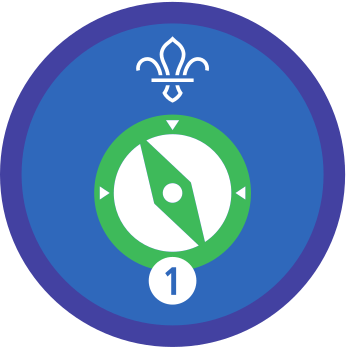
See you later, navigator
You’ll need
- Pens or pencils
- A4 paper
- Weather appropriate clothing
- Maps of the local area
- Chatterbox template
Prepare to navigate
In a meeting before this activity, everyone should talk about what they’ll near to wear, and what they may need to bring with them. They should make a list (with words or pictures) and check it with the person leading the activity. People might want to think about:
- What time of year is it? What clothing do you need in this season? What clothing don’t you need in this season but might need at another time of year?
- Do you need to check the weather forecast before you get ready? Why? What will it tell you?
- Do you need any specialist equipment for this activity? What specialist equipment should you leave behind (for example, this isn’t the time for buoyancy aids)?
- What might happen if you wear the wrong sorts of clothes for an activity? Would you enjoy it less? Could it be dangerous?
- What extra things do the adults need to have with them (for example, a list of everyone’s emergency contact numbers)?
Plan your route
- Split into an even number of groups, with at least two adults for each group.
- Each group should go on a short walk that takes no longer than 10 minutes. As they go, they should plan a simple route that starts and ends at their meeting place. They should mark this route on their map.
Make your chatterbox
Each group should make one chatterbox. They can use these instructions to help, or the person leading the activity may show everyone a video.
- Take the template, and cut out the square chatterbox.
- Put the template face down on the table, so you can’t see any of the writing. Fold it diagonally in half, and unfold. Fold it diagonally in half the other way, and then unfold.
- You should now have a square with a diagonal cross folded across the middle.
- Fold each corner of the square into the middle of the diagonal cross. You should now have a smaller square – one side should be covered in numbers, and the other in the words and the Scout logo.
- Turn the chatterbox over, so the words and Scout logo are face up. It should have a cross folded across the middle.
- Fold each corner of the square into the middle of the cross. You should now have an even smaller square.
- Fold the chatterbox in half and then in half again, and then unfold.
- Gently push out the square with the number one on it, to make a pocket for a finger or thumb. Repeat with all of the other numbered squares on the outside.
- Put your fingers inside these pockets, and pinch together. The top of your chatterbox should now come to a point – a bit like a pyramid.
Navigate
- Everyone should come together, and each group should pair up with another group.
- The pairs of groups should go outside. One group should lead the other group on the route they planned. Each member of the group should give two or three directions, then let someone else take a turn.
- The groups should use the chatterbox to decide how to give the directions. One person should hold the chatterbox. The person about to give directions should choose a number between one and four (from the four squares around the outside). The person holding the chatterbox should open and close it (in opposite directions) that number of times.
- They should then open the chatterbox a bit. The person about to give directions should choose a number from one of the triangles inside, and the person holding the chatterbox should open and close it (in opposite directions) that number of times.
- The person about to give directions should choose their final number from one of the triangles inside. The person holding the chatterbox should unfold it, to see which method of direction is underneath.
- The person about to give directions should give them in the way the chatterbox says. They may have to say (tell people, for example, ‘walk to the end of the road then turn left’). They could show (for example, using hand gestures like pointing) or draw (on a blank piece of paper, or using tracking signs on the floor). They could also use an unmarked map, for example, by pointing along it.
- Groups should swap – the group who followed directions should now give directions using the chatterbox, to lead the others around their route.
Reflection
This activity was a chance to communicate. Which way of communicating did you find easiest to use to explain the directions? Which way of communicating did you find easiest to understand and follow? Which methods do people use in day-to-day navigating (for example, online maps might say things out loud, or show on a map)? However you communicated, was it easy to be clear?
This activity also needed you to be a team player. Was it easy to take it in turns to give directions? How did you decide who would go when? Did you take it in turns to use the chatterbox? Did you all understand the other group’s directions the same, or did you sometimes disagree? Did you achieve your goal of navigating successfully? Why is it useful to have a team around you when navigating or giving directions?
Safety
All activities must be safely managed. You must complete a thorough risk assessment and take appropriate steps to reduce risk. Use the safety checklist to help you plan and risk assess your activity. Always get approval for the activity, and have suitable supervision and an InTouch process.
For an extra challenge, choose an area or route you’re unfamiliar with for your walk.
If anyone has any access needs, make sure all of the groups take these into consideration when planning their routes. You may want to cross out any places people can’t go, for example, crossing out paths with steps if these are a barrier for anyone.
You could also try this activity on a minibus ride.
All Scout activities should be inclusive and accessible.
